So, this is a bit off our normal subject matter, but it appealed to the mechanical nerd in me, and I figured at least a few of my readers would have the same reaction. If not, well, we’ve got a pair of very neat guns coming up tomorrow.
Anyway, I was browsing through the museum of the Carabinieri (a branch of the Italian military somewhere between infantry and military police) in Rome, and noticed a bicycle in one corner. Well, actually it was the Carcano that I noticed first, and then the bicycle that is was strapped to.
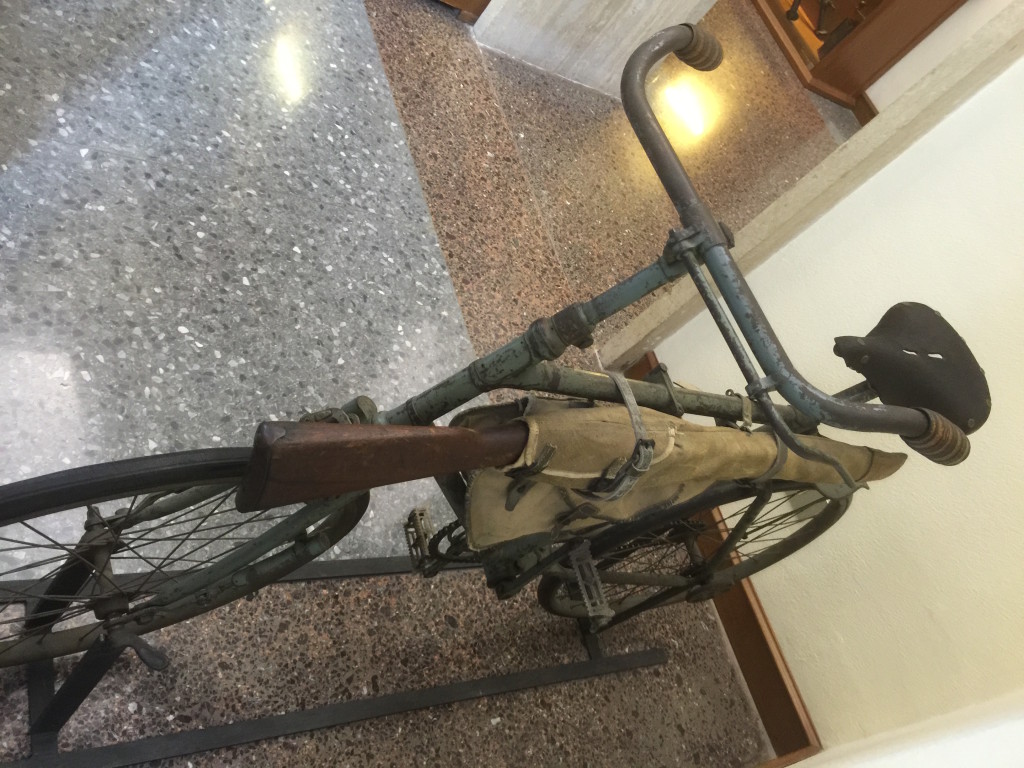
Lots of countries used bicycle troops to various degrees, and it’s interesting to see some of that gear firsthand. The rifle carrier is basically just a heavy canvas case strapped to the horizontal frame of the bike; nothing very complicated there. But, I figured I’d take a handful of photos in case someone out there has one of these and wants to restore it. This example isn’t exactly mint, but it could be useful to someone. Those photos are at the bottom of the post.
When I started looking more closely, I realized that this bicycle actually has front and back suspension systems. And they’re not quite like those on modern bikes, either – neat!
On the front wheel, there are a pair of cylinders (hydraulic or pneumatic, I don’t know which – possibly also mechanical springs) to damped impacts. Instead of being integrated into the front wheel fork, though, they are offset from it in order to add some leverage to the system. The wheel hub is connected to a level which pivots on the front fork and is connected to the dampening cylinders. Thus when the wheel goes up, the lever forces the cylinder to extend. Assuming it is fitted with a heavy coil spring inside (or a partial vacuum), this would cushion the rest of the bicycle from the shock hitting the front wheel.
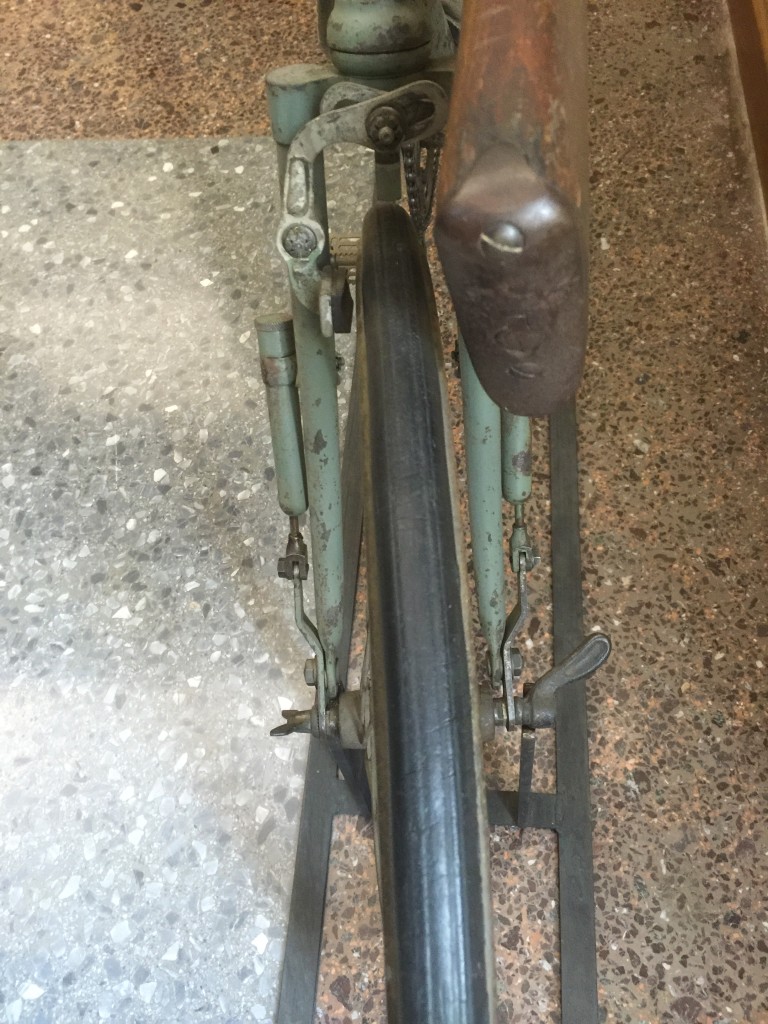
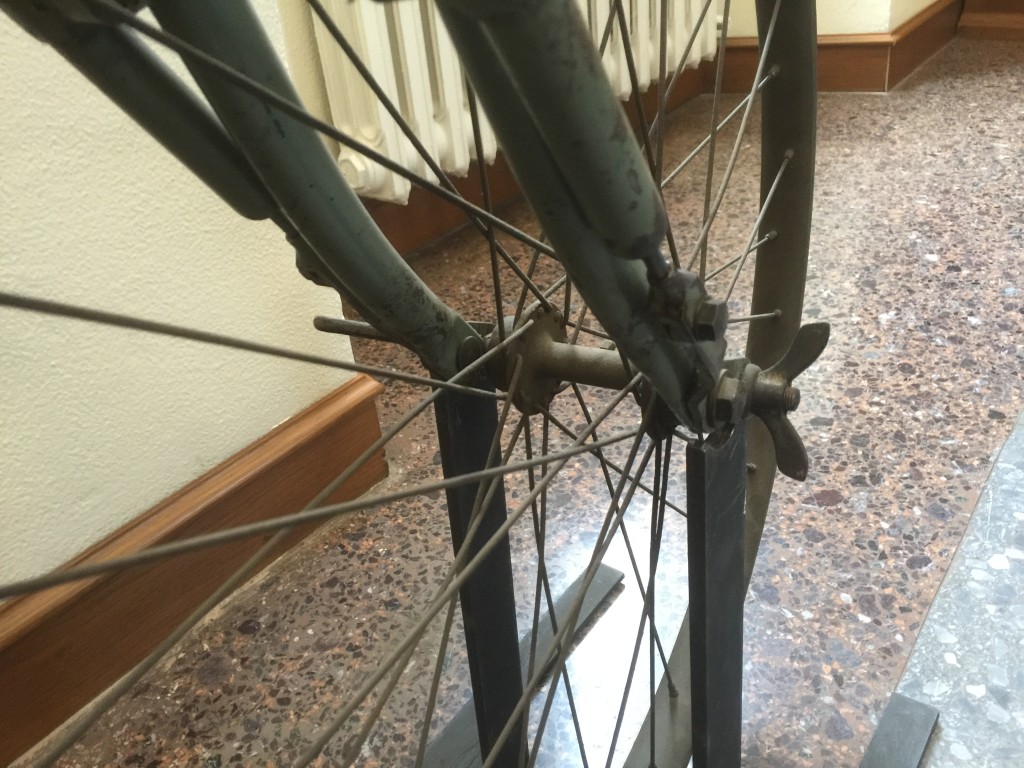
On the rear wheel, the cylinder is integrated into the frame, at the point where the rear fork attaches to the seat support.
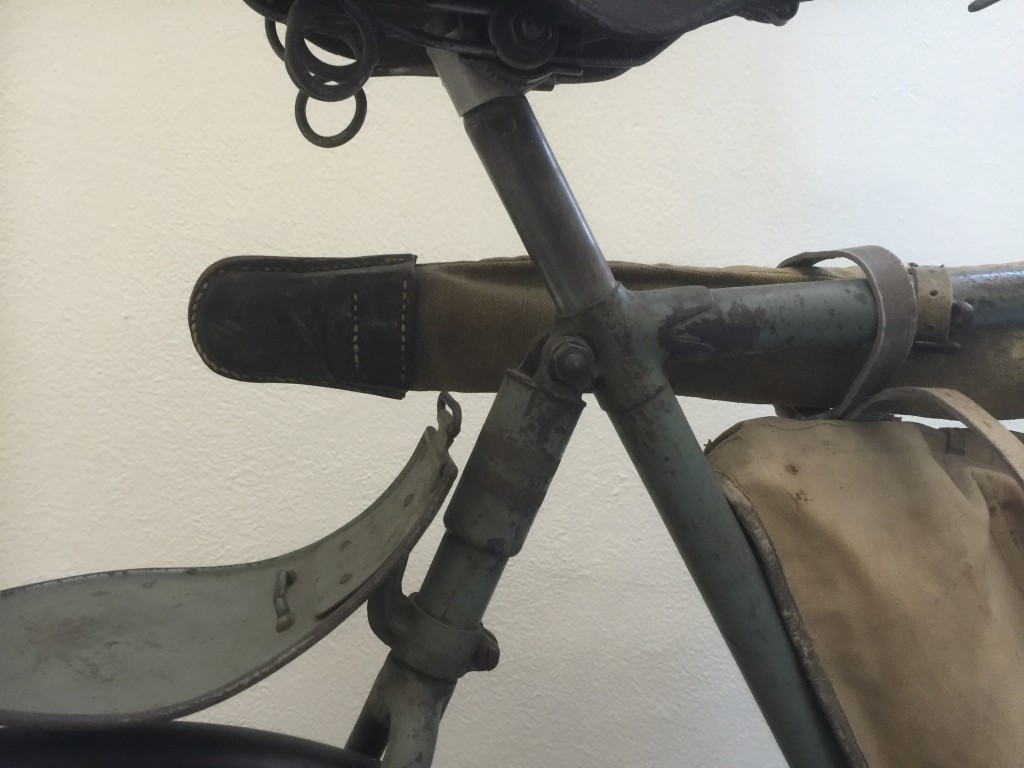
The interesting bit of the rear suspension not copied today (as far as I know) is the element allowing the rear wheel assembly to flex. That cylinder alone is not enough; there must be a second point that can move in order for it to be of any use. That second point is located just behind the pedals:
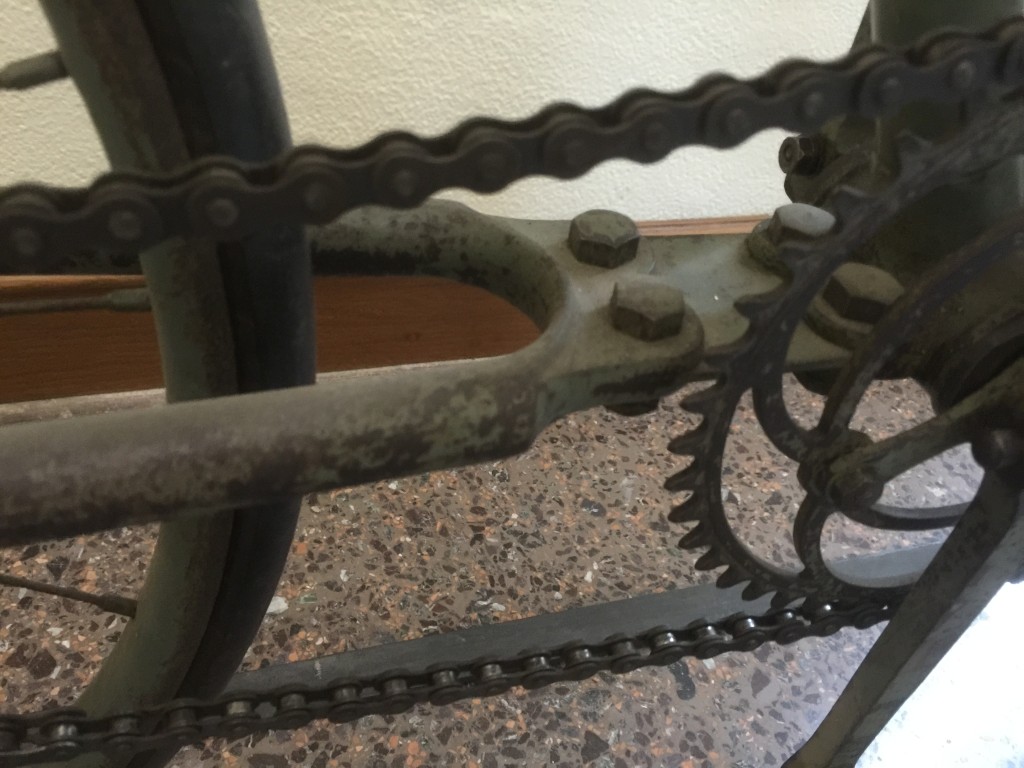
Instead of a fixed connection between frame and rear wheel, the two are attached via a flat piece of steel, presumably of a calculated thickness and heat treat. That piece acts as a leaf spring, allowing the rear wheel assembly to move up and down slightly in conjunction with the dampening cylinder beneath the seat. As long as the connecting piece is properly made, it would act as an effective (if stiff) shock absorber without ever flexing outside of its elastic zone (that is to say, without suddenly snapping in half at the worst possible moment).
The bicycle looks quite primitive at a casual glance, but actually has some sophisticated engineering built into its design. I do enjoy finding things like this…
As I mentioned above, here are the rest of my photos, should anyone find them useful:

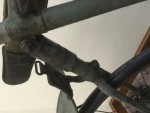

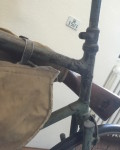
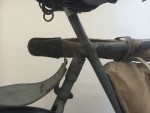
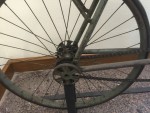
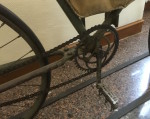

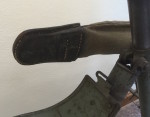
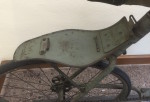
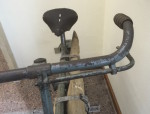
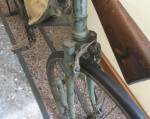
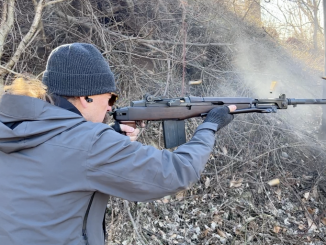

To get away, one just runs to the left… Bike steers left and gun stops front wheel… not hard to get away from that scout.
Why are you fleeing a scout? He should be fleeing from you. Your job is to run him down and knock him off his bike.
Was there a name plate on the frame? I noticed the letters FNI stamped on the saddle. It seems very early for the use of “full suspension” when the bike was made.
Actually, I think the front tire would clear the stock in a left turn. Still, neat bit of bicycle development (speaking as a 50 year bike nut) – interesting take on suspension, which was an eternal problem that didn’t find practical solutions until the 1990s. (Still not a fan of rear suspension, but I do like the front shocks on my “mountain” bike which is a good choice for Houston streets.) Any idea when made or by who? Looks like it could be anywhere from turn of the century to WW2 era; plus lots of early gun manufacturers had a bicycle line as well. (Iver Johnson bikes are worth more than most of their guns to collectors.) Sure there was a neat official canvas bag of gear that went on the back rack, shame that didn’t survive the years.
Cycling in Houston can be fun, but it can also be a bit off-putting what with the motorists…
If I returned to the streets of Houston by bike, this is how I’d like to go:
http://www.bevfitchett.us/heavy-machine-guns/images/3036_135_376-tank-firing-main-gun.jpg
That is cool!
Somewhere I’ve got a picture of a bike at a vintage rally in Ireland, with a SMLE clipped on in the same position.
But, IIRC, the bike was solid frame rather than with that very cool suspension.
I’ve also got a picture somewhere of a gentleman in Africa carrying a 10′ long corrugated galvanized steel sheet, rolled up in that position on his pushbike.
I gather that in the 1970s, Idi Amin had large numbers of the Ugandan army equipped with bicycles. Very effective where the roads frequently wash out, but less effective ammongst acacia thorns…
It looks like the bag is strapped on the wrong way. it would make more sense if it was on the right side of the frame with the butt facing back.
I have seen a picture somewhere of a group of Alpini using these bikes. An early Mountain Bike perhaps.
The Italian Bersaglieri used a 1912 Bianchi bicycle with a primitive spring suspension because to simplify maintenance and field use, it had solid rubber tires. The officers got pneumatic tires and, doubtless, some hapless officer’s batman to carry the patch kit and pump!
Here’s an online military bicycle museum that has the Italian Bianchi military bicycles. You’ll note the carrying equipment for weapons and so on, and the whole thing could be folded in half and lugged on the back as a sort of frame pack:
https://bsamuseum.wordpress.com/1911-bianchi-military-folding-bicycle/
As for bicycle troops, it would appear that the largest user of bicycles in military history was actually the German Wehrmacht in WWII! Of course, the Viet Minh and NLF/Viet Cong example of over-loaded Flying Pigeons and other Peugeot copies with wood-reinforced wheels, hauling tons of rice, ammuntion, etc. along forest tracks, across streams and so on is much more famous, albeit more a logistical use of cycling rather than a military bicycle per se.
The last European nations to use bicycle troops–until quite recently–included Finland, Denmark, and especially Switzerland.
You can see the WWII use of the later 1923 (year I or II of the “fascist era”) model during Italy’s disastrous involvement in WWII here:
http://www.regioesercito.it/articolivari/bici2agm.htm
scroll down for the bicyclists uniform and equipment.
I’ve seen a picture of one of these Bianchi proto-mountain bikes with a pintle-mounted twin-barrel 9mm Glisenti Villar-Perosa “sub”-machine gun on the handlebars! I’ll see if I can’t post a link…
Aha. Here it is (scroll down):
http://www.sadefensejournal.com/wp/?p=2782
And here is a getty image of a Fiat-Revelli with bicycle mount:
http://www.gettyimages.fr/detail/photo-d'actualit%C3%A9/system-of-machine-guns-on-a-bike-about-1918-gelatine-photo-dactualit%C3%A9/186419201
And I should mention that Ian has an image someplace here on Forgotten Weapons of Japanese soldiers using a bicycle frame to steady a 6.5mm hopper-loading Type 11 Nambu LMG!
Click here: http://www.istpravda.ru/artifacts/8644/ to see various bicycles in historic military usage.
And here: http://panzer-travelandhistory.blogspot.com/2010/09/blog-post_08.html
to see various method of attaching weapons and/or equipment to bicycles.
France, 1896:
http://shurick911.blogspot.com/2014/03/blog-post_4253.html
I am stealing one of those for a Saturday post. 🙂
Photos: military bicyclist (Самокатчики) in Tsarist Russia (mainly):
http://eremkin-kub.livejournal.com/299397.html
Can’t help but ask…how did that work out For them? 🙂
Very cool thanks for sharing. That is certainly the oldest suspended bicycle I have seen. I suspect the suspension was required due to what appear to be solid rubber, non-pneumatic tires. Those tires would have given a punishing ride without the suspension.
Leaf spring or flex plat suspension designs are still around used in the Funk La Ruta
http://www.funkcycles.com/bikes/la-ruta/
Also sort of in the Moots YBB design works similarly, just relying on the flex of titanium tubes.
Another interesting design detail that is common to the bikes of that time is the reversible rear wheel with two different fixed gear ratios. This allowed for a climbing gear in addition to a usual gear, but required removing the rear wheel and spinning it around to use the second gear.
Does any modern bicycle design employ the genius front brake designs of the Bianchi? Notice that there are no cables… The lever goes to a metal bar inside the headset, a bit like the old (annoying) German “spoon brakes” that rode on the tread of the front wheel, but instead, this operates the calipers on the rim…
Modern bicycles use disk brakes that are hydraulically actuated. Road bikes still use cable actuated rim brakes for the most part.
Right-o. That much I knew from my own “stable” of bicycles–there are also the coaster brakes too, of course. I’d rather hoped that a manufacturer someplace I hadn’t heard of before was making the Bianchi style front brake like our example Ian posted… Too bad!
FWIW, no one to my knowledge makes the type of lever-removable head-set that the German single-gear “Truppenfahrräder” employed. The headset and handlebars and spoon brake were pulled off so more bicycles could be fit in a truck or other compact space, and the German cyclist would pull the handle bars to “lock” the bicycle, since it can’t very well be ridden away in that condition! I’d love to see that feature come back too.
Incidentally, in the course of my own bicycle-born travels in Europe and Latin America, I have seen an old DDR “Karl Marx Stadt”–as Chemnitz was called–produced bicycle with a spoon brake. So that feature did continue on a bit past its expiration date!
As an engineer I question the usefulness of the front suspension. It would seem that the only boundary condition to stop excessive camber is the moment at the axel nut. In other words, the axel will bend if you apply high side load to the front wheel (skid sideways, or glance a rock). This is why most modern front suspensions have the double fork.
Tactically these troops would have to be used more like Dragoons (mount to move but fight on foot). I’ve always wondered why we don’t use them more in our current army for patrol or scout duty. Works for cops.
Ryan / All,
I was thinking that the front suspension was not entirely dissimilar to “leading link” motorcycle suspension, e.g. as fitted to traditional Honda 50s and many other small machines.
However those setups usually have compression springs that connect somewhere between the pivot and the axle.
Also, using motorcycle terminology, the rear suspension is arguably both a “monoshock” and a “softail” 🙂
The Honda 250’s in the 1950s and early 1960s had leading link suspension.
Also the pre-1952 HD’s did. This would include their WR 750 race bikes. The hub on a WR is comparatively narrower and of smaller diameter than it is on this bicycle. The WR flattrackers used a spool hub.
Given the wide hub and beefiness of the axle and hub on this bicycle, it’s design would work fine.
Older Officer of my acquaintance when asked about the new bike patrol officers: ” Rookie on a bike is still a rookie, but he can’t go as far or respond as fast as a rookie in a car.”
At least the biking rookie can’t be shot execution style since his side arm can be drawn in a hurry.
In an urban environment, with parks, sidewalks, parking garages, and so on, a bicycle patrol officer can, in fact, respond within a delimited area quicker than a flatfoot in a cruiser. Not every police operation entails a high-speed chase on the freeway, after all. As has been demonstrated time and again, within 20 to 15 miles, the bicycle is an efficient form of transport.
By now some actually sensible gear is available for bicycle police. I’d think a mesh vest for the service pistol and hand-cuffs and all that stuff would be better than the duty belt, however. There was a bicycle cop in Seattle who used an extra pair of cuffs to lock the bicycle, but apparently the powers that be made him stop, which is too bad. I thought it was clever. The city in which I currently reside often pulls heavy guys off the desk or whatever and makes them do bicycle patrol, apparently to whip them back into shape. It does lead to an impression of inefficiency for the bicycle patrol officer.
Thanks you satisfy the “Tech Nerd” in me.
“Lots of countries used bicycle troops to various degrees”
Swiss army used Ordonanzrad 05 which as number suggest is from 1905 until 1990s when it was replaced by Fahrrad 93.
Yes. The Ordonanzrad 1905 was a single speed, used until the 1980s/1990s, when it was replaced by a 7-speed mountain bike that had a metal bar to protect the vulnerable and flimsy derailleur. Ultimately, the Swiss abandoned mules and bicycles at about the same time, although Swiss I’ve talked to think it was a bad idea, insofar as Switzerland is a ruggedly mountainous nation, non-aligned, and reliant on imported oil and petrol… A good portion of the doppelgänger underground fortress-nation with its tunnels and bunkers has been abandoned too, of course. Probable security threats are very different these days.
I would imagine that riding a bicycle down the road with a near-naked rifle or shotgun strapped to it might attract some undue attention from police. A possible solution to those sorts of issues might be to design a “knockdown”-type bicycle whose tubular steel frame doubles as a rifle or shotgun barrel — perhaps somewhat similar to a cane-gun or “Nazi” belt-buckle gun in general principle. I don’t know if any such Bond-esque bicycles were ever developed, but such a contraption would seem an innovative way of getting a long gun past tight security.
And I used to think my Schwinn Lemon Peeler with the horizontal volute spring on the front fork and the gas struts in the rear was sophisticated!
I hope you kept it — those things are now selling for a fortune.
I think it is often not remembered or realized how much the use horses had an effect on the design of handguns around the turn of the last century.
Bicycles have not left a lasting impression on gun designs, but probably encouraged some of the sporting take-down rifles of the era. Who knows, if bicycles had been more prevalent in armies then maybe we would have seen cavalry-length rifles with folding stocks?
Takedown and folding rifles not only predate bicycles, they predate the metallic cartridge breechloader.
See Man at Arms, October 2015, “Marshall Tidd, Riflemaker Extraordinaire” by Stuart C. Mowbray, pp.14-24. Tidd (1820-1904) lived and worked in Woburn, MA, and specialized in highly-accurate heavy-barrel target rifles. All of his octagon barreled benchrest rifles separated at the breech for transport in either wooden cases or leather carriers.
Made in both iron-sighted and telescopic sighted versions, they were otherwise typical of the octagon-barreled “heavy” type we think of as Civil War “sniper rifles”, and many of his works did see service in that capacity with the Confederates.
In addition, Tidd made what he called “jack knife” rifles, light “buggy rifles” that actually folded around a trunnion built into the stock wrist behind the action, or in some cases a hinge pin ahead of the breech that allowed the barrel to fold down. In either case the barrel lay flush against the belly of the stock when the gun was folded.
A compartment in the stock generally held a ramrod, oil bottle, and cap container, and still had room for a few balls or even some pre-prepared paper cartridges. A leather case was also included.
Tidd stated that his “jack knife” rifles were mainly intended as “very handsome guns for the fair sex who have a love of hunting”. There is no denying that they are “handsome”.
The Tidd “jack knife” rifle may have inspired the U.S. Air Force issue M6 Aircrew Survival Weapon of the 1950s;
https://en.wikipedia.org/wiki/M6_Aircrew_Survival_Weapon
While the structure is different, the overall layout is remarkably similar, including the bar-type “trigger” under the stock.
cheers
eon
Since it seems such a perfect fit, it makes me wonder if the M6 Aircrew Survival Weapon was the inspiration for this part of the NFA’s AOW definition:
“any gun with combination shotgun and rifle barrels, 12 inches or more but less than 18 inches in length, from which only a single discharge can be made from either barrel without manual reloading”
Though I’ve always wondered what is supposed to happen if the gun’s barrel is less than 12″ (the apparent ban on pump, lever, or semi-auto is more understandable) — other than the fact that it (presumably) can’t be legally registered as an “Any Other Weapon”.
I may have been wrong on that assumption, as I just discovered that there are indeed guns that under US federal law (as interpreted by the ATF) are not classified as either handguns or rifles or shotguns or SBR/SBS or ‘any other weapons’ — and are thus legal to sell without any kind of federal tax stamp.
http://www.franklinarmory.com/XO-26_Letter__c_.pdf
in my experience, if it’s over 26 inches in length and it’s not full-automatic or above .50 caliber, ATF really doesn’t care what it does or doesn’t have bolted to it. The one exception being a rifle that’s had its barrel shortened below 16 inches.
Sometimes I used to find Swedish or other country bolt-action Mauser artillery carbines with what looked like a 1″ or 2″ long muzzle flash hider brazed on.
This was because their barrels were exactly 40 centimeters in length, as per metric specs. 40 centimeters is 15.748 inches. So U.S. surplus wholesalers added the permanently-mounted “flash hider” to bring them up to the U.S. 16 inch minimum plus a bit more, just to be safe.
As Col. Cooper said, silly laws promote transparent evasions.
cheers
eon
Great stuff Ian. Given the fact that many of our favorite firearms manufacturers have at one time manufactured Bicycles this is indeed on point. Most firearms geeks are also mechanical geeks, I know for I are one 😉 The only way this could be cooler would be if a known gun maker manufactured the bicycle.
Cantilever front brakes (missing the op rod), full suspension and intriguingly a flip-able rear wheel. Currently the rear is set up to freewheel but take it out and flip it 180 degrees and it will work as a fixed gear. This bike was ahead of it’s time. Great post Ian.
Unlike the modern-day hipster “fixie” the two gears on the Bianchi M1912 are a hill-climbing gear and a standard, not a fixie and a freewheel. Perhaps the closest modern-day analogue is the SRAM Automatix 2-spd. gear that switches based on revolutions, or perhaps the Sturmey-Archer “kick back” type hub.
Cool, I was looking at it on a somewhat small tablet but the far rear sprocket’s skeletonized area seems to include the area that the near sides freewheel covers. Not trying to be argumentative. I know nothing about this bike but would like to learn more about it.
Oh, I agree that the bike “was ahead of it’s time” and that it was a great post by Ian. Certainly a keen, excellent observation.
I’m told that much research has gone into “airless” or non-inflatable tires, but I haven’t seen any practical results on the bicycle market, much less any military application outside of say, certain wheeled APCs or whatever.
Tactically speaking, bicycle-equipped infantry was not meant for scouting (small squads) but for quick deployment of full companies and units that would then fight on foot, on the attack or while reinforcing defences.
The idea was that of quick deployment like cavalry, together with steadiness like infantry.
Kinda like the way that dragoon regiments were originally conceived during the age of pikes-and-shot, before Dragoons became just a different kind of Cavalry.
Or kinda like British Regiments used to assemble ad-hoc mounted infantry sub-units during the Victorian period.
In the United States, the whole “safety bicycle” craze with a chain and pneumatic tires led to a flirtation with bicycle troops as a possible replacement for cavalry. A group of African American troops with white, primarily Carolina-born officers rode 32-lb. Spalding bicycles with Krag-Jørgensen .30-40 service rifles, bed rolls, a haversack, and plenty of whiskey–the original “strength” inducing beverage–and rode all the way to St. Louis, MO to prove the notion. Along the way, a train would deliver additional supplies at various pre-ordained drop off points, where the bicycle troops would then retrieve them.
Nations in particularly flat terrain, like Belgium, portions of France, Germany, certainly Jutland/Denmark, portions of Sweden and Finland, etc. all took to bicycle infantry. Oddly, Italians and the Swiss, residents of some of the most ruggedly mountainous terrain, also tried to apply the principle of bicycle-borne infantry.
Again, perhaps surprisingly, the Germans in WWII probably made the largest and most widespread use of bicycles thinking that in a largely horse-drawn military that aspired to keep up with its vaunted Panzer and motorized divisions, the bicycle was at least swifter than foot-slogging infantry.
“in my experience, if it’s over 26 inches in length and it’s not full-automatic or above .50 caliber, ATF really doesn’t care what it does or doesn’t have bolted to it. The one exception being a rifle that’s had its barrel shortened below 16 inches.”
That’s because of the ATF’s (made up) rule that basically says “once a rifle, always a rifle.” It’s legal to build a stockless “rifle” from a new receiver but illegal to create an identical firearm from an existing rifle. So the short-barreled stockless “rifle” (that’s over 26″ long) is only a restricted firearm if it started out life as a rifle. Purpose-built stockless “SBRs” such as the Thompson 1927-A5 apparently fly under the ATF radar — but apparently it will instantly turn into an NFA weapon if ever carried under a raincoat (i.e., “concealed”). I’m always amazed at how idiotic, counter-intuitive, and contradictory US gun laws (as interpreted by the ATF) can be.
http://www.franklinarmory.com/PRODUCTS_XO-26.html
This forum has some info on the Wehrmacht version…. I especially like the one with the Panzerfausts
http://forum.axishistory.com/viewtopic.php?t=70557
oops….